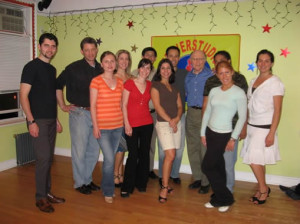
Tango class in Brooklyn at Dance Fever Studios.
There are really only three major types of steps in Argentine tango. Walking, giros(pivots) and ganchos(hooks). Almost every complicated pattern or amazing sequence you see, is composed of these three types of steps. 95% of your time dancing tango, you will be doing these types of steps. Most of the time you will be walking, some times pivoting, and less time hooking. Practice these three things, alone, by yourself, and you will be good.
Since most of your time is spent walking, this is what you should practice first. Again, practice without a partner. If you can’t walk a straight line forward and backwards, to different tempos, in total control of your balance, by your self; don’t expect to do it with a partner. Start with walking every two beats. Step on the 1 and the 3. These are called the strong beats. Walking slowly is much harder than fast. Practice this too. Step every 4th beat of the music. So, now you’re stepping on the 1st beat with the right, then the 1st beat with the left. Don’t use the free leg to help you balance. Keep your movement going over the entire 4 beats. Walk like a cat creeping up on a bird. There are some tango schools and teachers in Argentina that will only teach walking for the entire first year of lesson. Once you can walk the right way alone, you have a chance of doing it the right way with a partner. Now, that’s assuming that your partner also did the same practice. If not, she or he will be using you as a balance beam.
To see more videos go to our Youtube chanel.
Pivots. Once you have the walk, move on to pivots. If not, don’t start learning pivots. Just like walking, you need to be able to pivot by yourself, or you won’t be able to do it with a partner. Do not practice against a wall. This only gets you in the bad habit of relying on the wall for balance. Start with 1/4 pivots. Face one wall with your entire body. Now, turn only the upper part of your body, your torso, so that it faces the next wall. You will feel a pull. Your lower part wants to follow your upper part. Allow it to by pivoting on one foot. Now your body is aligned again, facing the next wall. Repeat this. These are 1/4 pivots. Go both ways. When you can do this well, move onto 1/2 pivots, then full 360 pivots. When you have these, do it backwards. Being able to do this is the basis for forward and backward ochos.
Ganchos, like walking and pivoting, you must practice on your own. Practice ganchos backwards, sideways and backwards over your own leg. Make sure you point your toe and maintain your balance. Do all this, and dancing with a partner will be a lot easier and more fun.